
Nitheesh NH
In our China Retail Insights series, we examine issues that affect international brands and retailers in China. We cover areas such as consumer behavior, consumer sentiment, emerging retail trends, government regulations and the competitive landscape—as they affect business operations and the future outlook of retail.
In this report, we explore a growing phenomenon in China—virtual influencers. We take a look at how this concept is evolving in China and the different types of virtual influencers. We also discuss how brands are tapping virtual influencers as a marketing tool, and the pros and cons of using digital characters to host online content.
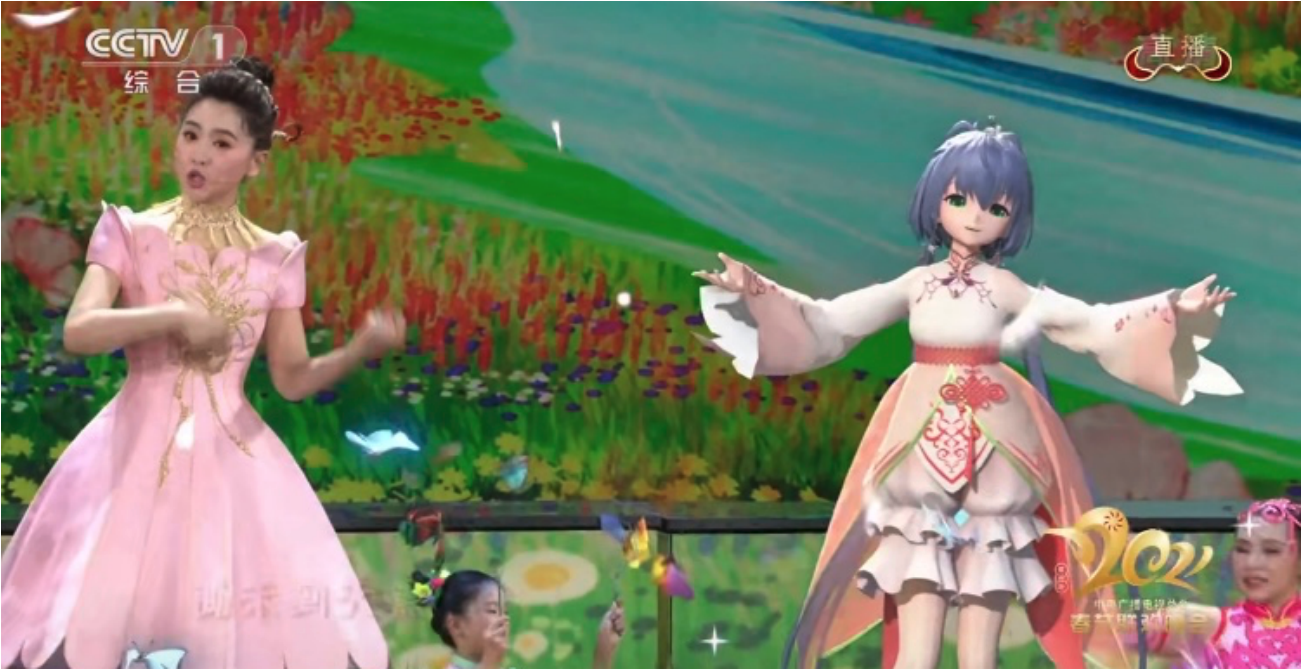 Virtual idol Luo Tianyi performed at the Chinese Spring Festival Gala
Virtual idol Luo Tianyi performed at the Chinese Spring Festival Gala
Source: Weibo[/caption] The commercialization of virtual singers has led to the emergence of more virtual influencers in recent years. Virtual influencers resonate well with young Chinese consumers. Many of those born after 1990 developed enthusiasm and attachment to ACG (“Animation, Comics and Games”) during their childhood. ACG is often referred to as the “two-dimensional space,” marking its distinction from the real-world, three-dimensional space. According to a report on virtual influencers published by video-streaming platform iQiyi in March 2020, over 390 million people followed virtual influencers in 2019, and the penetration rate among Gen Zers is particularly high. Types of Virtual Influencers There are generally four types of virtual influencers, which we outline below.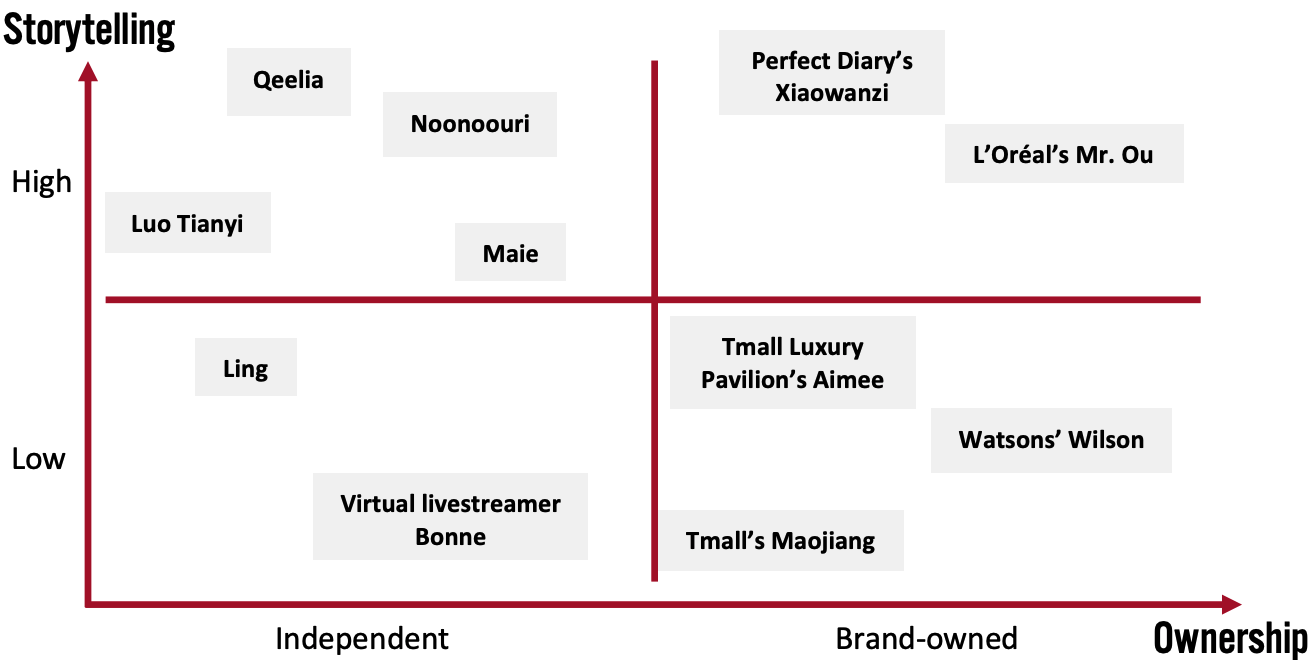 Source: Baidu[/caption]
How Can Brands and Retailers Leverage Virtual Influencers?
Below, we present notable examples of three ways in which brands and retailers can integrate virtual influencers into their product promotion and consumer engagement strategies.
1. Feature Virtual Influencers in Marketing Campaigns
As virtual influencers are popular among young consumers, brands and retailers can feature the characters in marketing campaigns to increase shopper engagement. This is particularly effective in the beauty, luxury and apparel sectors, as virtual influencers can be depicted wearing digital representations of the brand’s products.
In March 2021, Chinese luxury brand Zegna teamed up with brand ambassador and actor Li Xian and virtual influencer Noonoouri to promote the brand’s Spring 2021 Collection in a video campaign. The campaign featured Noonoouri, dressed in Zegna’s classic suit, discussing with Li Xian contemporary masculinity beyond gender stereotypes and social norms. As of the end of March, the video had received over 23 million views and 12,000 comments.
Prada Group is another luxury company that has leveraged virtual influencers in its marketing strategy. To celebrate the launch of its Prada and Miu Miu flagship stores on Alibaba’s Tmall e-commerce platform in March 2020, Aimee—a virtual influencer created by Alibaba’s Luxury Pavilion—wore the latest clothes and shoes from two brands. According to Lorenzo Bertelli, Head of Marketing and Communication at Prada Group, the company believes that using the virtual influencer to promote the brands’ products will help reach Gen Z consumers and enhance the customer experience.
[caption id="attachment_127092" align="aligncenter" width="720"]
Source: Baidu[/caption]
How Can Brands and Retailers Leverage Virtual Influencers?
Below, we present notable examples of three ways in which brands and retailers can integrate virtual influencers into their product promotion and consumer engagement strategies.
1. Feature Virtual Influencers in Marketing Campaigns
As virtual influencers are popular among young consumers, brands and retailers can feature the characters in marketing campaigns to increase shopper engagement. This is particularly effective in the beauty, luxury and apparel sectors, as virtual influencers can be depicted wearing digital representations of the brand’s products.
In March 2021, Chinese luxury brand Zegna teamed up with brand ambassador and actor Li Xian and virtual influencer Noonoouri to promote the brand’s Spring 2021 Collection in a video campaign. The campaign featured Noonoouri, dressed in Zegna’s classic suit, discussing with Li Xian contemporary masculinity beyond gender stereotypes and social norms. As of the end of March, the video had received over 23 million views and 12,000 comments.
Prada Group is another luxury company that has leveraged virtual influencers in its marketing strategy. To celebrate the launch of its Prada and Miu Miu flagship stores on Alibaba’s Tmall e-commerce platform in March 2020, Aimee—a virtual influencer created by Alibaba’s Luxury Pavilion—wore the latest clothes and shoes from two brands. According to Lorenzo Bertelli, Head of Marketing and Communication at Prada Group, the company believes that using the virtual influencer to promote the brands’ products will help reach Gen Z consumers and enhance the customer experience.
[caption id="attachment_127092" align="aligncenter" width="720"]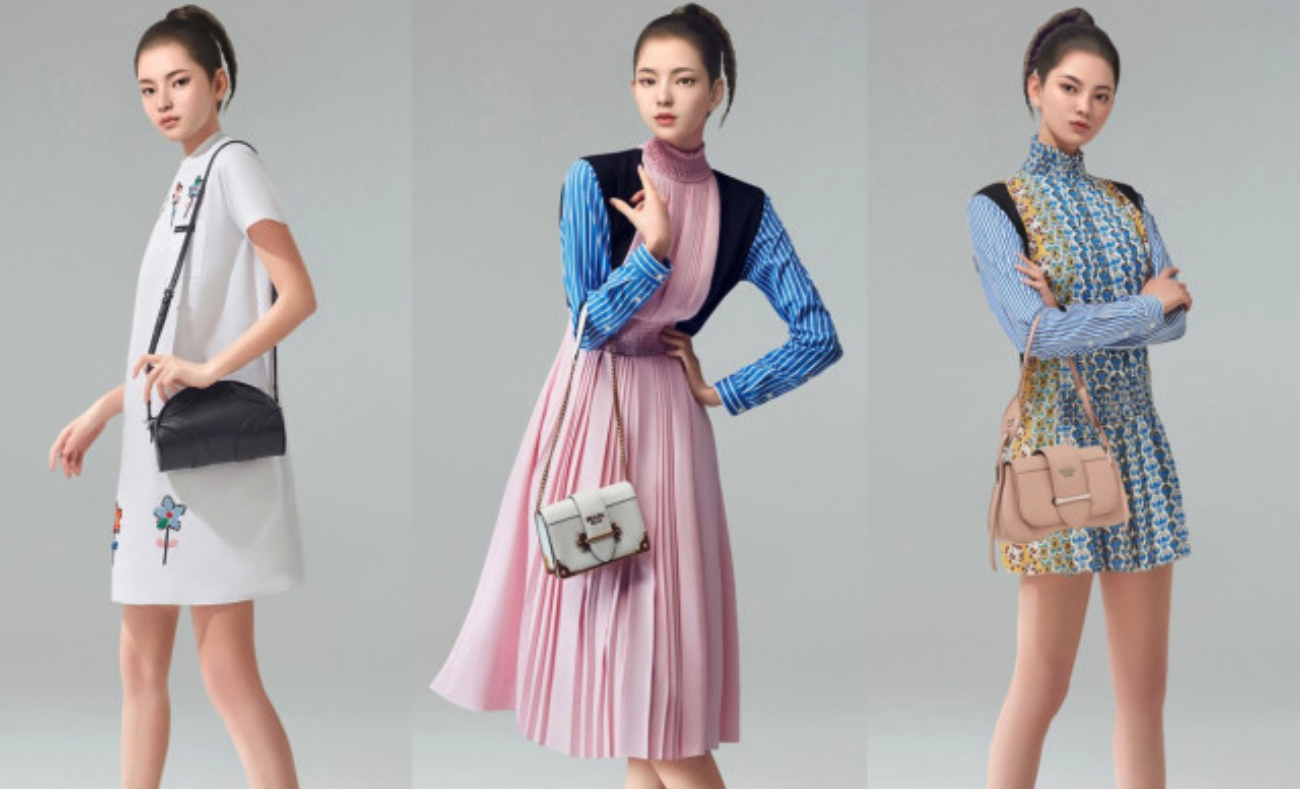 Virtual influencer Aimee wears fashion items from Prada
Virtual influencer Aimee wears fashion items from Prada
Source: Prada Group[/caption] Cosmetics brand Fenty Beauty by Rihanna partnered with virtual influencer Qeelia in January 2021 to market its New Year limited-edition beauty giftbox on Weibo. Qeelia is depicted as an 18-year-old young girl who loves fashion, dancing and art, and she uses social media to showcase her lifestyle as Gen Z. Qeelia has previously worked with brands including Dell, Puma, French fashion brand Zadig & Voltaire Uniqlo and more. [caption id="attachment_127093" align="aligncenter" width="720"]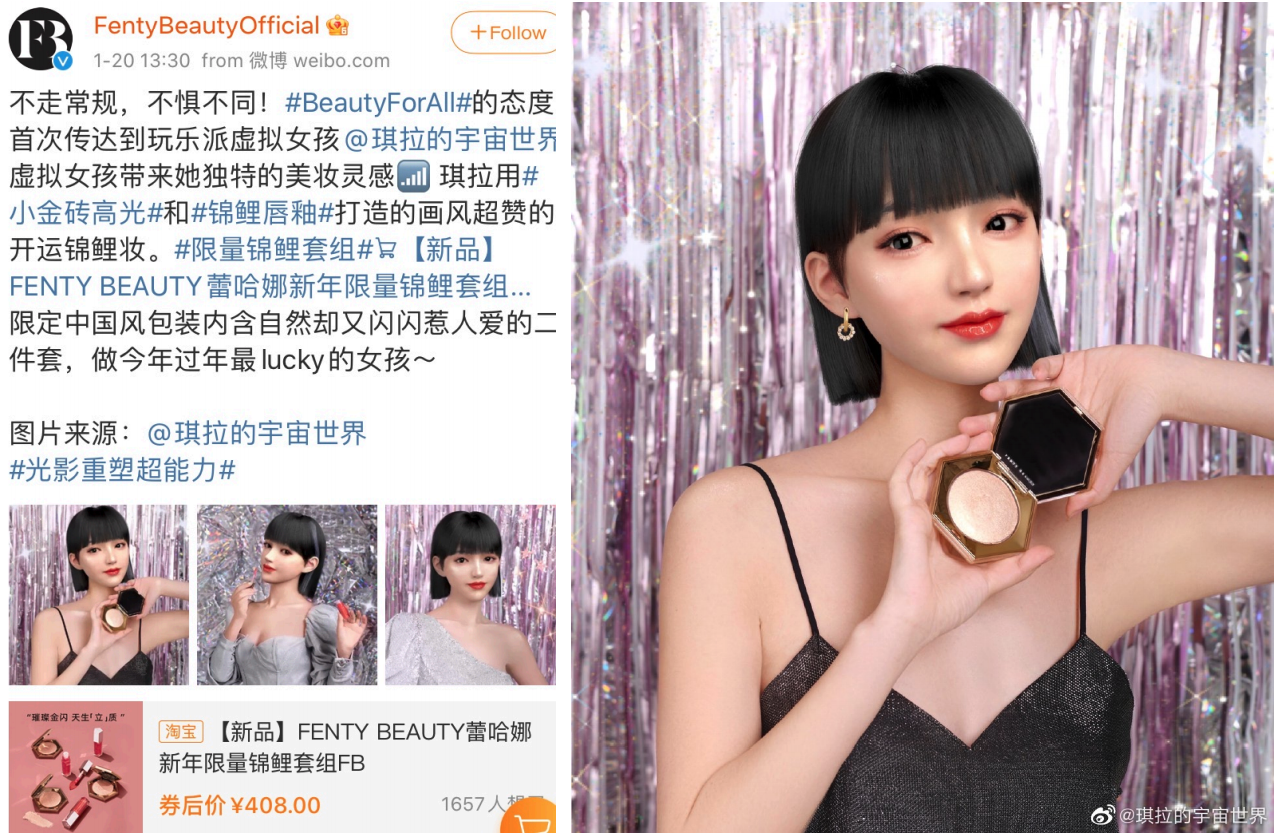 Fenty Beauty tapped virtual influencer Qeelia to promote its New Year limited-edition beauty set
Fenty Beauty tapped virtual influencer Qeelia to promote its New Year limited-edition beauty set
Source: Weibo[/caption] 2. Use Virtual Livestreaming Hosts Livestreaming is one of the biggest trends in China, and we continue to see it as a valuable marketing tool for brands and retailers to engage with consumers and drive sales. Coresight Research estimates that livestreaming e-commerce in China will total $300 billion in 2021—representing 14.3% of the nation’s total e-commerce market. Internet giant Alibaba has enriched its shopping experiences by introducing virtual livestreaming hosts to interact with viewers, powered by intelligent cognitive technologies. AI-powered virtual hosts offer brands a cost-efficient alternative to hiring real hosts. During Singles’ Day 2020, Chinese snack brand Three Squirrels and jacket brand Bosideng, as well as international brands such as L'Oréal and Unilever, broadcast some of their livestreaming sessions with AI-powered hosts, enabling them to promote their products through long livestream sessions. According to Three Squirrels, sales generated from livestreaming exceeded ¥8 million (around $1.2 million) during November 1–3, 2020, of which the sales driven by virtual hosts were almost the same as the human host. [caption id="attachment_127094" align="aligncenter" width="580"]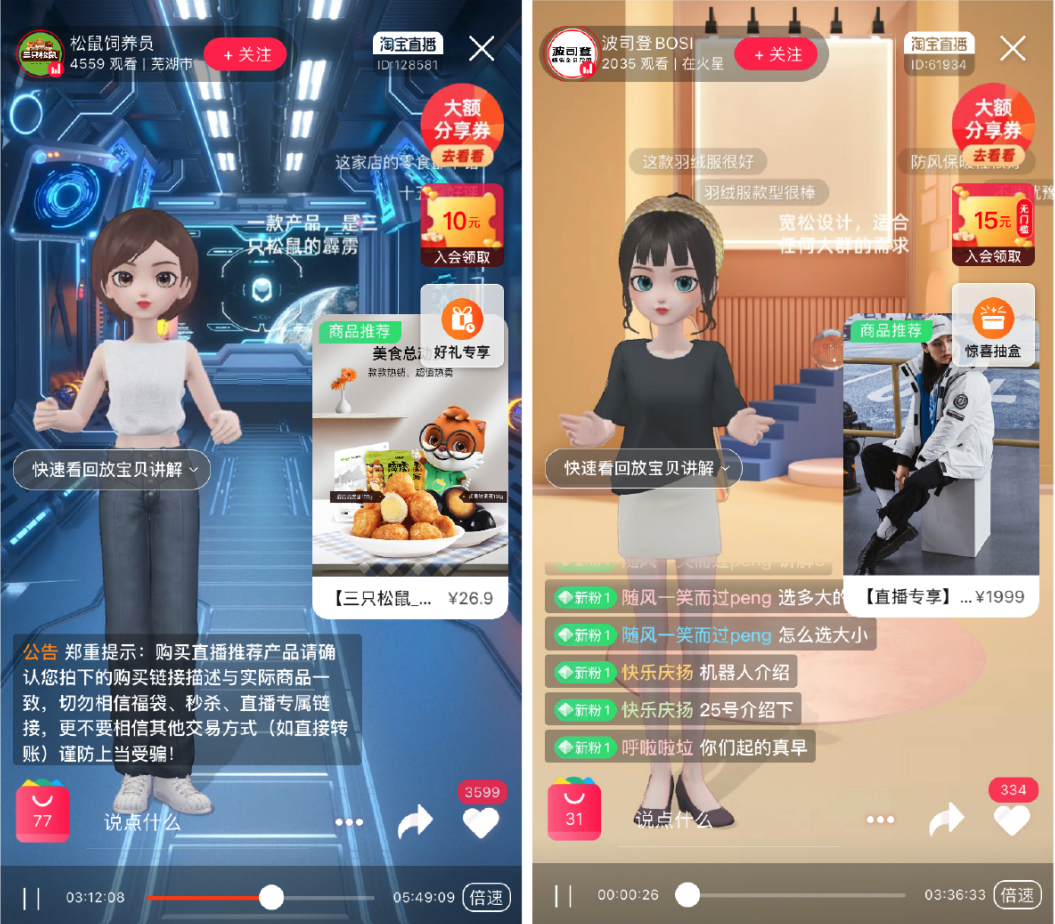 Livestreaming sessions with virtual hosts broadcast by Three Squirrels’ (left) and Bosideng (right)
Livestreaming sessions with virtual hosts broadcast by Three Squirrels’ (left) and Bosideng (right)
Source: Taobao[/caption] Livestreaming sites such as Taobao Live and Douyin have been incorporating pre-existing virtual influencers in livestream sessions. For example, in April 2020, Luo Tianyi co-hosted a session with top KOL (key opinion leader) Austin Li, which attracted almost 3 million viewers at its peak. During the 6.18 Shopping Festival in June 2020, Japanese virtual singer Miku also joined Taobao Live. 3. Create Your Own Virtual Influencers We have seen some brands choose to launch their own virtual influencers as brand ambassadors. For now, these influencers are more like avatars that do not utilize any AI technology (therefore do not require high levels of investment). Chinese domestic beauty brand Perfect Diary is a pioneer in online marketing innovation. Recognizing that social media platform WeChat was a key driver of private traffic (fully owned and managed by the brands in closed and direct channels), Perfect Diary created a fictional character, “Xiaowanzi,” in 2019, which consumers can add as a friend on the platform. Through a private WeChat group, Xiaowanzi shares beauty tips, promotions and product information, as well as engaging with consumers in casual conversation. In early March 2021, L’Oréal announced its first two-dimensional male virtual influencer, Mr. Ou, which the brand describes as a 24-year-old Chinese-French entrepreneur who works in the beauty industry and cares for the environment. The virtual character will act as brand advocate, responsible for contributing content on L’Oréal’s social media sites related to beauty trends, educating consumers on product ingredients and sustainability initiatives, and conducting interviews with actual influencers and celebrities. [caption id="attachment_127095" align="aligncenter" width="320"] L’Oreal’s first male virtual idol, Mr. Ou
L’Oreal’s first male virtual idol, Mr. Ou
Source: Weibo[/caption] Benefits and Drawbacks of Virtual Influencers Virtual influencers could play an important role in appealing to young consumers in China, benefiting brands that hope to refresh and modernize their brand image. The biggest advantage of virtual influencers is that they are completely controllable; they can convey brand’s value and narrative that are perfectly tailored to the company’s preference. More importantly, they do not get involved in controversial or inappropriate behavior that could damage the brand’s image and put off consumers. Although virtual influencers are on the rise, brands and retailers need to be aware of several drawbacks as well. Depending on the form of virtual influencer, its development could be costly if using advanced technology such as 3D modeling and AI. Building out realistic virtual figures, from their backstories to body language and interactions, requires a huge amount of investment. Furthermore, if a character appears in a livestream session, the concept needs additional investment in voice actors to have the virtual influencer talk and respond spontaneously. Two-dimensional characters are the most budget-friendly, but their simplistic design as general cartoon avatars may not excite young shoppers. While the launch of L’Oréal’s new two-dimensional virtual influencer Mr. Ou generated media attention, it did not gain popularity among Chinese netizens on social media. It is still too early to assume that virtual influencers can spark the same level of devotion among fans that Chinese KOLs and celebrities boast, or actually drive sales conversion. In addition, just as human influencers can, virtual ones may raise authenticity concerns on product endorsements.
The Next Wave of Virtual Influencers: In Detail
What Is a Virtual influencer? Virtual influencers are digital creations with fan support—they represent the next evolution of virtual “idols,” although the two terms are often used interchangeably. The first virtual popstar dates back to as early as 1996 in Japan, but it was not until 2007 that the idol concept gained mainstream popularity through Japanese virtual idol Hatsune Miku—an anime character who sings through a vocal synthesizer. In 2012, Chinese technology company Shanghai Henian Information Technology created its own virtual singer, Luo Tianyi. She was the first Chinese virtual idol to hold an offline live concert. As of early May 2021, Luo Tianyi had over 5 million followers on Chinese microblogging site Weibo. She hosts livestreaming sessions with celebrities and also performed during the famous Chinese Spring Festival Gala on February 11, 2021, which was broadcast on local television. [caption id="attachment_127090" align="aligncenter" width="720"] Virtual idol Luo Tianyi performed at the Chinese Spring Festival Gala
Virtual idol Luo Tianyi performed at the Chinese Spring Festival GalaSource: Weibo[/caption] The commercialization of virtual singers has led to the emergence of more virtual influencers in recent years. Virtual influencers resonate well with young Chinese consumers. Many of those born after 1990 developed enthusiasm and attachment to ACG (“Animation, Comics and Games”) during their childhood. ACG is often referred to as the “two-dimensional space,” marking its distinction from the real-world, three-dimensional space. According to a report on virtual influencers published by video-streaming platform iQiyi in March 2020, over 390 million people followed virtual influencers in 2019, and the penetration rate among Gen Zers is particularly high. Types of Virtual Influencers There are generally four types of virtual influencers, which we outline below.
- Virtual singers were the first to emerge. Early virtual idols tended to take the form of ACG figures, but they have become more 3D-like as technology has progressed.
- Virtual characters derived from pre-existing IP (intellectual property) capitalize on the existing fan base of an animation or game. For example, Chinese Internet giant Tencent’s online game Honor of Kings is one of the most-played video games in China, and the major characters in the game have gained high levels of popularity among players. Brands and retailers usually choose to launch cross-over collaboration products with these types of virtual singers and characters.
- Virtual influencers can be developed by independent technology firms. For example, Qeelia is a virtual fashion influencer produced by technology startup and multichannel network company Blue Wildebeest Technology. With more than 470,000 followers on Weibo, Qeelia shares her daily life and works with brands to promote products. In May 2020, Chinese artificial intelligence (AI) startup Xmov Information Technology and Beijing Cishi Culture Media Company unveiled China’s first AI virtual influencer, Ling, to showcase Chinese traditional culture such as Peking Opera. Xmov used its self-developed AI technology to create the facial expressions and body movements of the character.
- Many brands and retailers have established their own in-house virtual influencers to connect with consumers.
 Source: Baidu[/caption]
How Can Brands and Retailers Leverage Virtual Influencers?
Below, we present notable examples of three ways in which brands and retailers can integrate virtual influencers into their product promotion and consumer engagement strategies.
1. Feature Virtual Influencers in Marketing Campaigns
As virtual influencers are popular among young consumers, brands and retailers can feature the characters in marketing campaigns to increase shopper engagement. This is particularly effective in the beauty, luxury and apparel sectors, as virtual influencers can be depicted wearing digital representations of the brand’s products.
In March 2021, Chinese luxury brand Zegna teamed up with brand ambassador and actor Li Xian and virtual influencer Noonoouri to promote the brand’s Spring 2021 Collection in a video campaign. The campaign featured Noonoouri, dressed in Zegna’s classic suit, discussing with Li Xian contemporary masculinity beyond gender stereotypes and social norms. As of the end of March, the video had received over 23 million views and 12,000 comments.
Prada Group is another luxury company that has leveraged virtual influencers in its marketing strategy. To celebrate the launch of its Prada and Miu Miu flagship stores on Alibaba’s Tmall e-commerce platform in March 2020, Aimee—a virtual influencer created by Alibaba’s Luxury Pavilion—wore the latest clothes and shoes from two brands. According to Lorenzo Bertelli, Head of Marketing and Communication at Prada Group, the company believes that using the virtual influencer to promote the brands’ products will help reach Gen Z consumers and enhance the customer experience.
[caption id="attachment_127092" align="aligncenter" width="720"]
Source: Baidu[/caption]
How Can Brands and Retailers Leverage Virtual Influencers?
Below, we present notable examples of three ways in which brands and retailers can integrate virtual influencers into their product promotion and consumer engagement strategies.
1. Feature Virtual Influencers in Marketing Campaigns
As virtual influencers are popular among young consumers, brands and retailers can feature the characters in marketing campaigns to increase shopper engagement. This is particularly effective in the beauty, luxury and apparel sectors, as virtual influencers can be depicted wearing digital representations of the brand’s products.
In March 2021, Chinese luxury brand Zegna teamed up with brand ambassador and actor Li Xian and virtual influencer Noonoouri to promote the brand’s Spring 2021 Collection in a video campaign. The campaign featured Noonoouri, dressed in Zegna’s classic suit, discussing with Li Xian contemporary masculinity beyond gender stereotypes and social norms. As of the end of March, the video had received over 23 million views and 12,000 comments.
Prada Group is another luxury company that has leveraged virtual influencers in its marketing strategy. To celebrate the launch of its Prada and Miu Miu flagship stores on Alibaba’s Tmall e-commerce platform in March 2020, Aimee—a virtual influencer created by Alibaba’s Luxury Pavilion—wore the latest clothes and shoes from two brands. According to Lorenzo Bertelli, Head of Marketing and Communication at Prada Group, the company believes that using the virtual influencer to promote the brands’ products will help reach Gen Z consumers and enhance the customer experience.
[caption id="attachment_127092" align="aligncenter" width="720"] Virtual influencer Aimee wears fashion items from Prada
Virtual influencer Aimee wears fashion items from PradaSource: Prada Group[/caption] Cosmetics brand Fenty Beauty by Rihanna partnered with virtual influencer Qeelia in January 2021 to market its New Year limited-edition beauty giftbox on Weibo. Qeelia is depicted as an 18-year-old young girl who loves fashion, dancing and art, and she uses social media to showcase her lifestyle as Gen Z. Qeelia has previously worked with brands including Dell, Puma, French fashion brand Zadig & Voltaire Uniqlo and more. [caption id="attachment_127093" align="aligncenter" width="720"]
 Fenty Beauty tapped virtual influencer Qeelia to promote its New Year limited-edition beauty set
Fenty Beauty tapped virtual influencer Qeelia to promote its New Year limited-edition beauty setSource: Weibo[/caption] 2. Use Virtual Livestreaming Hosts Livestreaming is one of the biggest trends in China, and we continue to see it as a valuable marketing tool for brands and retailers to engage with consumers and drive sales. Coresight Research estimates that livestreaming e-commerce in China will total $300 billion in 2021—representing 14.3% of the nation’s total e-commerce market. Internet giant Alibaba has enriched its shopping experiences by introducing virtual livestreaming hosts to interact with viewers, powered by intelligent cognitive technologies. AI-powered virtual hosts offer brands a cost-efficient alternative to hiring real hosts. During Singles’ Day 2020, Chinese snack brand Three Squirrels and jacket brand Bosideng, as well as international brands such as L'Oréal and Unilever, broadcast some of their livestreaming sessions with AI-powered hosts, enabling them to promote their products through long livestream sessions. According to Three Squirrels, sales generated from livestreaming exceeded ¥8 million (around $1.2 million) during November 1–3, 2020, of which the sales driven by virtual hosts were almost the same as the human host. [caption id="attachment_127094" align="aligncenter" width="580"]
 Livestreaming sessions with virtual hosts broadcast by Three Squirrels’ (left) and Bosideng (right)
Livestreaming sessions with virtual hosts broadcast by Three Squirrels’ (left) and Bosideng (right)Source: Taobao[/caption] Livestreaming sites such as Taobao Live and Douyin have been incorporating pre-existing virtual influencers in livestream sessions. For example, in April 2020, Luo Tianyi co-hosted a session with top KOL (key opinion leader) Austin Li, which attracted almost 3 million viewers at its peak. During the 6.18 Shopping Festival in June 2020, Japanese virtual singer Miku also joined Taobao Live. 3. Create Your Own Virtual Influencers We have seen some brands choose to launch their own virtual influencers as brand ambassadors. For now, these influencers are more like avatars that do not utilize any AI technology (therefore do not require high levels of investment). Chinese domestic beauty brand Perfect Diary is a pioneer in online marketing innovation. Recognizing that social media platform WeChat was a key driver of private traffic (fully owned and managed by the brands in closed and direct channels), Perfect Diary created a fictional character, “Xiaowanzi,” in 2019, which consumers can add as a friend on the platform. Through a private WeChat group, Xiaowanzi shares beauty tips, promotions and product information, as well as engaging with consumers in casual conversation. In early March 2021, L’Oréal announced its first two-dimensional male virtual influencer, Mr. Ou, which the brand describes as a 24-year-old Chinese-French entrepreneur who works in the beauty industry and cares for the environment. The virtual character will act as brand advocate, responsible for contributing content on L’Oréal’s social media sites related to beauty trends, educating consumers on product ingredients and sustainability initiatives, and conducting interviews with actual influencers and celebrities. [caption id="attachment_127095" align="aligncenter" width="320"]
 L’Oreal’s first male virtual idol, Mr. Ou
L’Oreal’s first male virtual idol, Mr. OuSource: Weibo[/caption] Benefits and Drawbacks of Virtual Influencers Virtual influencers could play an important role in appealing to young consumers in China, benefiting brands that hope to refresh and modernize their brand image. The biggest advantage of virtual influencers is that they are completely controllable; they can convey brand’s value and narrative that are perfectly tailored to the company’s preference. More importantly, they do not get involved in controversial or inappropriate behavior that could damage the brand’s image and put off consumers. Although virtual influencers are on the rise, brands and retailers need to be aware of several drawbacks as well. Depending on the form of virtual influencer, its development could be costly if using advanced technology such as 3D modeling and AI. Building out realistic virtual figures, from their backstories to body language and interactions, requires a huge amount of investment. Furthermore, if a character appears in a livestream session, the concept needs additional investment in voice actors to have the virtual influencer talk and respond spontaneously. Two-dimensional characters are the most budget-friendly, but their simplistic design as general cartoon avatars may not excite young shoppers. While the launch of L’Oréal’s new two-dimensional virtual influencer Mr. Ou generated media attention, it did not gain popularity among Chinese netizens on social media. It is still too early to assume that virtual influencers can spark the same level of devotion among fans that Chinese KOLs and celebrities boast, or actually drive sales conversion. In addition, just as human influencers can, virtual ones may raise authenticity concerns on product endorsements.